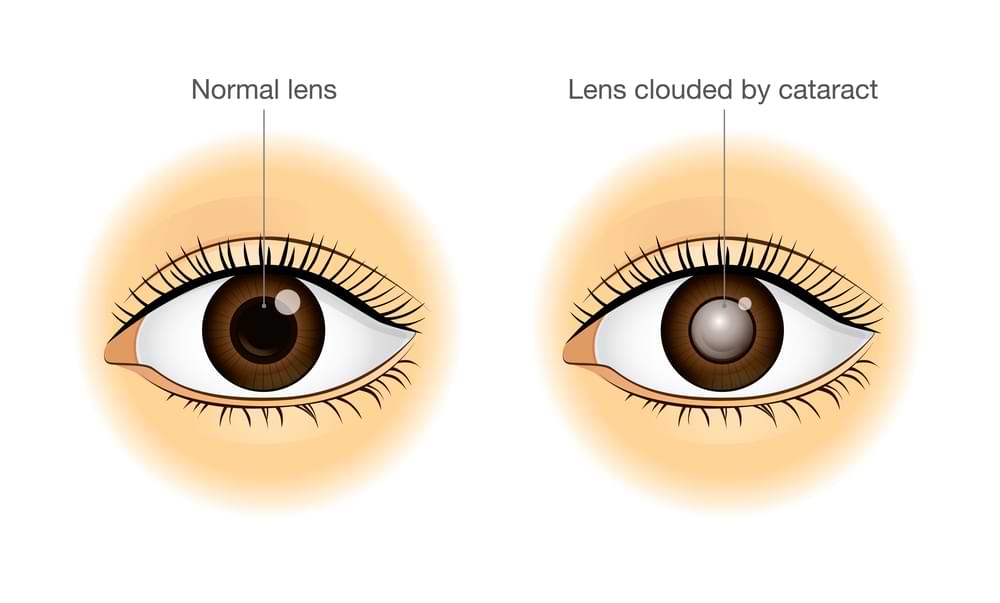When Should I Get A Cataract Eye Exam?

Have you ever wondered at what age cataracts start to interrupt your eyesight and begin to impact your quality of life? Many people believe cataracts only affect the very elderly. But did you know lifestyle factors and certain conditions can hasten their development, even at a younger age?
Let me introduce myself. My name is Minh Van Tran, the proud owner and principal optometrist at VisionPro. Nestled in the heart of inner west Melbourne, Victoria, our practice has become a cornerstone for taking care of eye health in our aging community. With a higher proportion of elderly individuals experiencing cataracts, we’ve tailored our services to excel in managing this condition. Our overall mission is to offer comprehensive, compassionate, and modern eye care.
Cataracts are a leading cause of vision impairment and blindness among older adults. Failing to stay informed leads to a higher risk of severe vision impairment. So, why wait for your vision to worsen? Book your eye care consultation today and stay ahead of eye health issues.
Or keep reading to learn more about protecting your vision through cataract eye exams.
How Does Age Influence Cataract Eye Exam Frequency?
The recommendation for when to start getting cataract eye exams generally depends on individual risk factors, but here are some general guidelines:
- Starting at Age 40: It’s advisable for adults to begin having comprehensive eye exams every two to four years starting at age 40. While these exams check for more than just cataracts, they can help detect early signs of cataract development.
- Age 50 and Above: As you reach your 50s, it’s wise to increase the frequency of eye exams as cataracts are more common in this age group.
- Age 60 and Older: By age 60, annual eye exams are recommended. At this age, the risk of cataracts and other eye diseases increases significantly, making regular check-ups crucial for early detection and management.
- High-Risk Individuals: People with certain risk factors are advised to start earlier and have exams more often, depending on their doctor’s recommendations.
- Symptoms Appear: Regardless of age, if you experience symptoms such as blurred vision, difficulty seeing at night, halos around lights, or frequent prescription changes, you should schedule a comprehensive eye exam promptly. These could be signs of cataracts or other eye conditions.
It’s always best to consult with an eye care professional who can provide personalized advice based on your specific health history and risk factors.

Cataract Risk Factors
Here are key risk factors that necessitate more frequent and earlier cataract screenings:
- Diabetes: When blood sugar levels are consistently high, as they often are in individuals with diabetes, sugar molecules in the eye can attach to the proteins in the lens, a process known as glycation. This disrupts the arrangement of the lens proteins, leading to cloudiness and opacity.
- Prolonged Steroid Use: Steroids are often used to reduce inflammation in conditions like asthma, arthritis, or autoimmune diseases. Their long-term use, especially when taken systemically (as pills or injections that affect the entire body), can lead to specific changes in the eyes known as posterior subcapsular cataracts, which form at the back of the lens of the eye.
- History of Eye Injuries: When the eye experiences trauma, it can lead to various complications, one of which is the formation of secondary cataracts. The lens of your eye is encased in a thin capsule and is designed to remain clear throughout most of your life. However, when an injury occurs to the eye fibers within the lens can break down or become disorganized, leading to cloudiness in areas that were previously clear.
- Smoking: Smoking increases the risk of cataracts by altering the cells within the lens through oxidative stress and other mechanisms. Smokers are significantly more likely to develop cataracts compared to non-smokers, making regular eye exams a priority.
- Excessive Alcohol Consumption: Research indicates that there is a link between heavy drinking and the formation of cataracts. When consumed in large amounts, alcohol can lead to oxidative stress in the body. Over time, this can damage the proteins and lens fiber cells in the eye, leading to the clouding characteristic of cataracts.
- Excessive Exposure to UV Light: UV light accelerates the aging of the lens, leading to cataract formation. Prolonged exposure to the sun without adequate eye protection increases this risk, underscoring the need for protective measures like sunglasses.
- Family History: Genetic mutations that cause cataracts can be hereditary. An inherited predisposition to the disease means that those with a family history of this condition need to catch and manage the disease early.
- Ethnic Background: Research indicates that certain ethnic groups, including South Asians and Indigenous Australians, are at a higher risk of developing cataracts.
Understanding these risk factors can help tailor the frequency and commencement time of your comprehensive eye exams, ensuring proactive management of your eye health. This approach not only helps in preserving your vision but also enhances your overall quality of life by addressing potential issues before they become severe.
Cataract Symptoms You Should Have Checked
Cataract surgery may be required when the symptoms caused by the cataracts significantly impact your quality of life.
- Objective Level of Vision: One of the most straightforward indicators that cataract surgery may be needed is your level of visual acuity. If your vision with glasses or contact lenses is 20/40 or worse, and the cause is primarily due to cataracts, it may be time to discuss surgical options with your eye care professional. This level of vision means that what a person with normal vision can see from 40 feet away, you can only see clearly from 20 feet away.
- Glare: Cataracts can cause problems in situations like driving at night where headlights cause more glare than usual, or when sunlight seems blinding even though it’s not particularly bright. A glare test, conducted by your optometrist, can assess how light scatter affects your vision and can help in deciding whether surgery is necessary.
- Ability to Perform Daily Tasks: The impact of cataracts on your ability to perform everyday tasks is perhaps the most critical factor in deciding to have surgery. If you find it difficult to engage in usual activities such as reading, using a computer, and recognizing faces, then cataract surgery might improve your quality of life. The decision is often based on whether these difficulties can be attributed mainly to poor vision caused by cataracts.
If you’re experiencing one or more of these symptoms, and cataracts are the cause, it’s a good indication that it might be time to consider surgical options. Regular and frequent cataract eye exams will give you the opportunity to discuss cataract surgery with your optometrists, and seek a referral to an ophthalmologist if necessary.
Watch the following video by Dr Michele Lee for more information that may guide you whether the time is right to see a surgical eye doctor.
Key Components of a Cataract Eye Exam
When you visit our clinic for a cataract eye exam, it’s important to understand both the preparation required and the thorough nature of the examination. This ensures that you are fully informed and can benefit maximally from the comprehensive assessment of your vision and eye health.
- Preparation for the Exam: Before your appointment, gather any relevant medical history and previous eye exam results to help tailor the examination to your specific health needs. It’s also important to list all medications you are currently taking, as some may impact your vision, and note any recent changes in your eyesight.
- Visual Acuity Test: The first step in the cataract examination is the visual acuity test. This assesses how clearly you can see at various distances, providing an initial gauge of your vision’s sharpness. It’s a fundamental part of the exam that helps to determine if there are any immediate impairments that need further investigation.
- Slit Lamp Examination: Following the acuity test, I use a slit lamp to examine your eye’s internal structures at high magnification. This tool is crucial for assessing the health of the front structures of the eye, including the cornea, iris, and natural lens. The slit lamp helps to identify any abnormalities or early signs of cataracts.
- Dilated Eye Exam: To get a comprehensive view of the internal parts of your eye, a dilated eye exam is performed. By dilating the pupils with special eye drops, I can examine the lens, retina, and optic nerve more clearly. This is vital for detecting diseases that affect the deeper structures of the eye, such as cataracts and retinal disorders.
- Ophthalmoscope Usage: Lastly, I use an ophthalmoscope to examine the back of your eyes. This tool allows me to look at the retina and optic nerve, which are critical for your eye health. Examining these areas is essential for a thorough evaluation, especially for identifying stages of cataract development and other potential eye health issues.
- Results Interpretation: After the examination, I will explain all findings, discussing any signs of cataracts and their potential impact on your vision. We will evaluate your lifestyle and visual needs to determine the best management plan, which may include regular monitoring or surgical options if necessary.
A cataract eye exam at our clinic is a detailed, multi-step process designed to ensure your eye health is thoroughly assessed and managed. By being well-prepared and understanding each step of the exam, you can actively participate in maintaining and enhancing your vision. This proactive approach is key to managing your eye health effectively and ensuring the best possible outcomes.
Cataract Treatment Options
When diagnosed with cataracts at VisionPro, you have access to both surgical and non-surgical treatment options, tailored to suit the stage and impact of your cataracts. This ensures optimal outcomes for your eye health, based on your specific needs.
- Surgical Treatment Options: If cataracts significantly impair your vision, surgery may be recommended. This typically involves an outpatient procedure where the clouded lens is replaced with a clear artificial one. The surgery is safe, usually takes less than an hour, and most patients notice improved vision almost immediately. Post-surgery, you’ll follow specific care instructions, including using eye drops to prevent infection and attending follow-up visits to ensure proper healing.
- Non-Surgical Management: For early-stage cataracts, or if you wish to delay surgery, non-surgical management may be appropriate. This includes lifestyle modifications such as wearing UV-protective glasses, following a diet rich in antioxidants, and managing health conditions like diabetes that could accelerate cataract progression. Some cataract sufferers find improvement by wearing stronger prescription glasses, using brighter lighting or relying more on magnifying lenses.
At VisionPro, managing your cataracts involves personalized care plans, depending on your specific condition and preferences. Our commitment to providing detailed education and ongoing support ensures that you remain informed and comfortable throughout your treatment journey, enhancing your quality of life through better vision and health. We also coordinate with specialists for those needing surgery, ensuring comprehensive care.
CONCLUSION
Anyone can be at risk for cataracts due to factors like age, lifestyle, and genetics, making personalized screening schedules essential. Delaying cataract treatment can result in unnecessary discomfort and limit your ability to enjoy activities you love.
Make the decision to prioritize your eye health today; a simple appointment could be the key to preserving your vision and enhancing your quality of life.
Scheduling an eye exam appointment is the first step to restoring or maintaining quality of life.
Click on the “BOOK AN APPOINTMENT” button OR call either our St. Albans (03) 9364 5509 or Footscray (03) 9687 8787 optometry practices.

Minh gained his Bachelor of Optometry in 2000, and his Certificate in Ocular Therapeutics (ACO) in 2016.
He started VisionPro Optometrists in 2008 and has been Principal Optometrist ever since, working in both the Footscray and the St Albans practices.
Minh is a member of Optometrist Association Australia and the ACO. He always strives to achieve the highest standard of professionalism when delivering eyecare to all his patients.
Minh’s special areas of interest include ocular diseases and management, children’s vision and contact lens fitting. Minh enjoys travelling and reading in his spare time.
